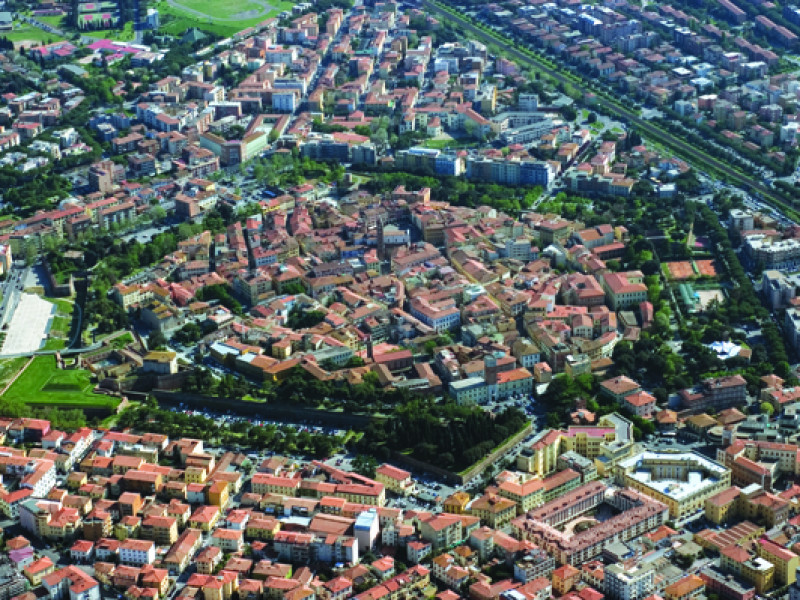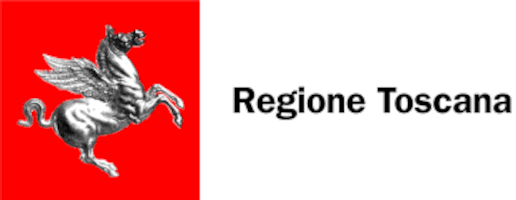


Grosseto was not born yet when its plain was covered by water and two etruscan cities, Roselle and Vetulonia, had their dominion on this lagoon. In fact it's now certain that the city area was occupied as a village only during the Early Middle Ages, and in particular since the VII century.
Grosseto, mentioned as a locus in 803, dues its origins probably to the village that the archaeological excavations conducted during the first years 2000 have localized on the Eastern part of the historical centre. The excavations done in 1978 by Siena's University had alredy found some cabins' traces in the area of the Forteress, on the slight elevation corresponding to Piazza Pacciardi (five meters compared to porta vecchia): this elavation protected the village from Ombrone River's floodings wich were quite frequent, as the river flowed very colse to Porta Vecchia.
Excavations permetted to study the ancient soils too and they have shown that floodings were very common since the Early Middle Ages; vegetation was a mix of marsh plants in the humid areas and mediterranean forest or pinetree forest in the dry ones.
The presence of cultivated plants increases during the Early Middle Ages, in connection to the birth of the city.
The name Grosseto included since the first documents reguarding the village may mean that the it could be in use before the city was born. This name seems to be tied to vegetation because of its ending in -eto, which could indicate an area where vegetation is rich and luxuriant, due to the aboundance of water in the ground. The name Grosseto coud be similar to other toponyms as Grasceta and Grascetone. It cannot be excluded that the name Grossus was at the ethimologycal origin of the name Grosseto.
The excavation inside Saint Peter's Church brought to light the certency that, during the VIII and IX Century, public and relevant buildings were made by stones in Grosseto, so that the village showed itself as a plural agglomaration of cabins with the main cheurches made by stone (at list Saint Peter's and Saint George's church, named in a document which dates back to the IX Century). We can suppose that the village was already surrounded by a fortification, probably a wooden palisade: in fact Groseto was remembered in a document of the X Century, as a castrum, meaning a fortified settlement.
Since the IX Century Grosseto was under the dominion of Aldobrandeschi family. The city and its territory reamained as a property of this noble Longobardian family untill the XIII Century. Along this period the city became the most important and strategical place of the area.
In 1138 Grosseto became a civitas thanks to the inheritance of the bishopric of Roselle: the city acquired a new shape caracterized by stone and bricks buildings which replaced the wooden Early Middle Ages buildings. Documents reveal how, during the following years, Grosseto had a free Comune despite the presence af a strong family as the Aldobrandeschi one was: the self alliance that Grosseto community dealed with Siena, in 1151 was a sign of its increasing independence. Between 1240 and 1250, Frederic II's troups occupied the entire Aldobrandeschi's county. During the XIV Century the city suffered a couple of devastating floods (1308 and 1333) which removed the River ombrone from the city proximity, so that Grosseto had its port no more. Between 1334 and 1336 Siena conquered Grosseto and became the only dominant city of Southern Tuscany. The construction of the Cassero wiyh Santa Lucia's door is the symbol of the submission of Grosseto to Siena.
The series of catastrofic events of the XIV century was not finished: a devastating epidemy of Great Mortality devasted Europe between 1347 and 1350. in 1348 it arrived in Tuscany killing between 30 and 50% af population. Maremma, caracterized by a low density of population, suffered a real demographic collapse, which remained low untill the XX Century.
News about the city become sporadic between the XIV and the XV Century, maybe for the many catastofic events that caracterize this period. However the decoration of the interiors of the cathedral become very rich in art masterpieces: Madonna delle Ciliege by Sassetta, Madonna delle Grazie by Matteo di Giovanni, sculpures by Antonio Ghini are just some examples of the art floridity of this period.
When the medici family conquered Siena, in the second half of the XV Century, Grosseto became part of the conquest. The building of a new bastion city wall was a priority for the Medici family, despite the difficulties due to the vast expense and the prohibitive environment. The new walls transformed grosseto in a stonghold: the most important miltary city of the Tuscan Granduchy, bench mark of a coast defence system which looked Southward, to the Spanish Stato dei Presidi and to the see, often crossed by the Corsairs comeing from the North of Africa. At the same time the urbanistic shape of the city was restored and became the one we see nowdays, inside the walls.
The attention for hygene and environment brought to the foundation of a new hospital and the establishing of the Diches Office encharged to dig wells and cisterns. The monasteries of Saint Frances and the Clares were restored. The same happened to the cathedral.
Medician policy, however, limited Grosseto's freedom and increased tax burden so that the economy of the city was damaged and the important and huge work of improoving the territory were complitely vanified. The colonial exploitation af maremma brought a big demigraphic shock: population passed from 3000 inhabitants in 1615 to 884 inhabitants of 1745.
In 1737 international policy delivered Tuscany to a foreiner dinasty, the Lorena, which is still remembered for their rational and incisive policy. The attention for marginal lands of the Granduchy ad the assiduous cure for Maremma created a special connection between Grosseto and the Grand Dukes: the statue in Honor of Leopold II (done between 1824 and 1859) in the main square of the city is an evidence of this connection.
Interventions were addressed to two particular aspects: environmental and economic recovery. Streets and ports were enlarged and inceased; salt production was relounched.
All that had evident on society: Grosseto became a real city, the capital of the Provincia Inferiore Senese, made autonomous by Petro Leopoldo in 1766. Population started to grow again, also because of immigration: from 8884 people in 1745 to 2732 in 1833 and 4724 in 1861, despite medium life was around 20 years old: about a half years comparing the rest of the Granduchy. New landowners, often foreiners, artisans and merchants became part of the new burgeois class.
The positive tendency went over until Napoleonic crisis, untill a new increase with the reign of Leopold II, almost thirty years later. The opening of big sites of reclamation (1828) produced a subtantial increasing of immigration flows. It is in this period that the city changes the most in its shapes and functions: the city walls, accsessible by many points, were partially privatized and partially became gardens; Accademia degli Industri promoted the construction of the first city theatre in 1813: the Cathedral facade was radically restored between 1816 and 1845: this was the first part of a long season of interventions which were concluded only in 1911. Piazza Dante became complitely new to host the statue of the most beloved and still living Grand Duke ever, in 1846.
A fwe years after it, the new unified State promoted and encouraged the construction of public buildings for the new institutional functions: the Townhall building, the Courthouse building, the prison, the King Elementary school and the new theatre were built inside the city walls rspectively in 1870-73, 1884 and 1888. Sometimes they were built restoreing some old building, sometimes destroying what was older.
The beginning of the XX Century is caracterised by a strong intervantion in the main square, starting from the name, changed from Piazza Grande to Piazza Vittorio Emanuele II. The most part of the medieval buildigs on the Eastern side of the square were destoied to make space to the new Provincia building in a neogothic style. The building is traditionally called Palazzo Aldobrandeschi because folkloric history wants the castel of this family to be in that same place, but this story has not historical foundation and archaeological excavations did not find anything refering to a castle or an arstocratic building.
outside the city walls the increasing of the city was very fast starting from the end of Eightundreds. It could not be different, if we consider the population growth rate: 4724 inhabitants of 1871 became more then 10.000 in the first years of 1900; they became 17.059 in 1921 and 38190 in 1951. After becoming 50.000 in 1960 and 70.000 in the eighties, population is around 80.000 nowadays.
The defited of malaria during the '50s and the realization of the land reform done during the fifties and sixties are the most important motivation of this growth.
21
Dec



PIANO DI SVILUPPO E COESIONE – PSC TOSCANA
INTERVENTI DI CUI ALLE RISORSE FSC DELIBERA CIPESS 26/2021
Supporto alla valorizzazione dell’immagine della Toscana – Maremma Toscana Area Sud
Progetto Maremma Toscana Area Sud